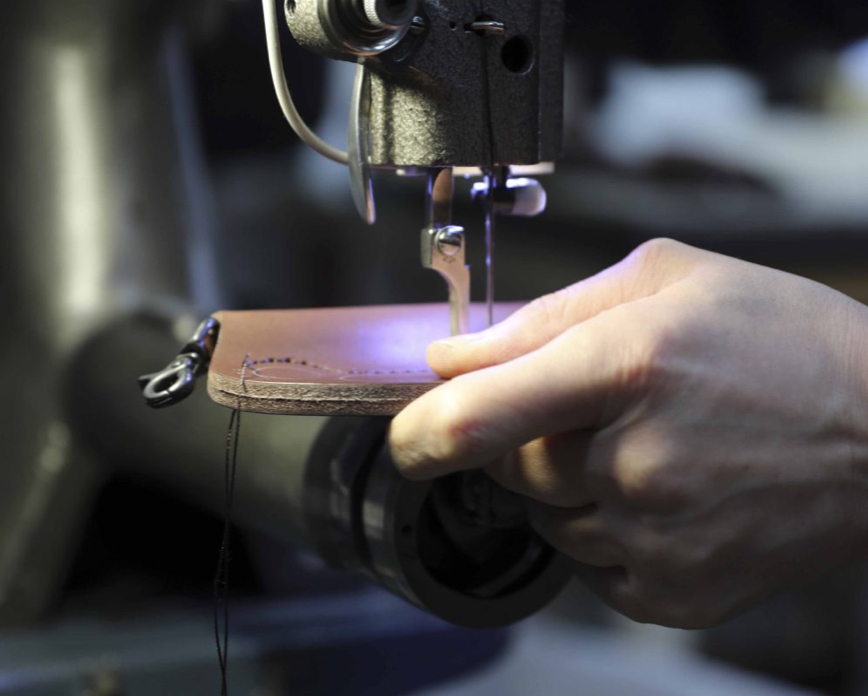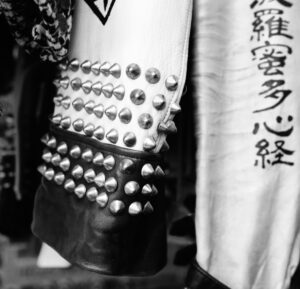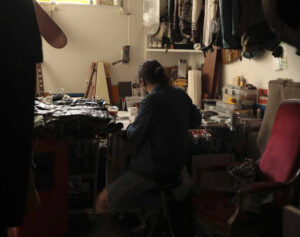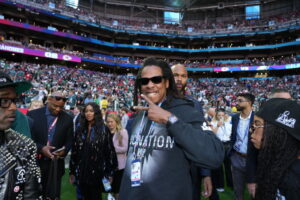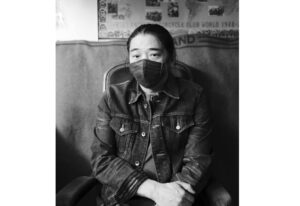
In the increasingly fast-paced and algorithm-driven fashion landscape of 2025, few brands carry the weight of their history while fearlessly charging into the future like BLACKMEANS. Founded by Yujiro Komatsu and brothers Masatomo and Takatomo Ariga, the Tokyo-based label has never fit neatly into conventional fashion brackets. It is not purely heritage, nor simply avant-garde. It is a living artifact—at once punk, spiritual, brutal, and exacting.
Over the past two decades, BLACKMEANS has become internationally recognized for its artisanal leather garments—each piece hand-crafted, each seam dense with context. But beyond the jackets and studs, the brand continues to act as a portal: a way of understanding the invisible history of Japanese leatherwork, the creative rebellion against class structures, and the philosophy of subculture as identity.
In this 2025 update, we examine how BLACKMEANS continues to thrive at the intersection of manual craft, political memory, and visionary experimentation—all while navigating the harsh truths of a struggling industry.
CRAFT AS RESISTANCE: CREATING FROM THE EDGE
From the beginning, BLACKMEANS was born with a deep awareness of what it meant to work in leather—especially in Japan. As Komatsu explains, “Starting a leather brand meant shouldering not just a creative vision but the burden and complex past of the leather industry itself.”
In Japan, leather has historically occupied a complicated space. The craft was long associated with the burakumin, a marginalized class under Japan’s feudal caste system who were forced into occupations considered impure, including butchering and tanning. This systemic discrimination extended into modern eras, where leatherworkers often remained socially invisible despite their essential contribution to Japanese manufacturing.
Komatsu and Ariga refuse to forget this. Instead of marketing darkness or victimhood, they embed this hidden legacy into their DNA. “Even if we don’t shine a spotlight on it directly, not acknowledging that history is the same as erasing it,” Komatsu says. “So BLACKMEANS carries that name with intent. It’s both respect and inheritance.”
In 2025, when social justice is often reduced to slogans, BLACKMEANS remains quietly radical—allowing history to guide the hand without distorting its shape.
THE LEATHER FACTORY AS CREATIVE INCUBATOR
What makes BLACKMEANS particularly distinct in Japan’s crowded fashion scene is that its workshop is not just a factory, but a crucible of experimentation. Having worked with collection brands for years before launching their own, the founders understand how technical knowledge fuels innovation.
Leather, unlike cotton or synthetic materials, requires patience and precision. It stretches and resists, scars and stiffens. Most designers simplify when faced with such a medium. But BLACKMEANS leans in—cutting, sewing, patching, dying, distressing, and hand-finishing every piece until it becomes not just a garment but a textural biography.
“We want to make things people have never seen before,” Komatsu affirms. “And we want to do it seriously, in ways that only someone who’s been working with leather for decades can.”
The studio’s walls are filled with test pieces—patchworked pants made from 30+ swatches, hybrid biker coats that transform when unzipped, shredded vests whose motifs resemble Jomon period tattoos. Some never make it to market. “But it’s important,” Ariga notes. “This is where the new comes alive.”
CONFRONTING AN INDUSTRY IN CRISIS
Despite their international acclaim, BLACKMEANS exists in a leather industry facing mounting pressure. Rising costs, environmental criticism, and supply chain instability have made many Japanese brands pivot away from leather altogether. But Komatsu and Ariga are prepared.
“We’ve always had the mindset that we’d be here even if things got bad,” Komatsu says. “Because for us, it’s not a trend. It’s not about market demand. It’s about craft and identity.”
That said, the brand doesn’t ignore the present. They’re increasingly shifting toward responsibly sourced hides, small-batch production, and modular garments that can be repaired, reworked, or passed down.
In 2025, BLACKMEANS also introduced a re-leathering program, where customers can send back aged pieces to be restored, re-dyed, or reshaped into new designs. “It’s not upcycling in a fashionable sense. It’s a ritual,” says Ariga.
This forward-thinking stance has placed BLACKMEANS at the center of discussions around craft longevity, not just sustainability. It’s not about optics. It’s about making things that last longer than hype.
THE MINIMALISM CONTRAST
As global fashion moves toward sterile minimalism—neutrals, clean silhouettes, and tech-driven design—BLACKMEANS is doing the opposite. Their latest collections channel wild proportions, tactical layering, and visual maximalism. Why?
“Because it stands out now,” Komatsu laughs. “The more everything looks the same, the more we get to show what difference looks like.”
And yet, nothing is gratuitous. Every spike, every dye stain, every oversized seam is intentional and earned. “There’s always logic in the madness,” Ariga adds. “It’s just that we refuse to do things halfway.”
This anti-minimalist stance is also a rejection of flattened aesthetics. The brand values depth—both literal and metaphorical. You feel it in their jackets: the weight, the stitching, the distress. You sense it in the way they cut leather into non-Euclidean patterns, pushing the body and the garment into unfamiliar geometries.
PHILOSOPHY: THE “SALAD BOWL” THEORY
When asked about influence and cultural coexistence, Komatsu shares a memory from his teenage years: “I remember learning about the term salad bowl—how different cultures can exist side by side, retaining their uniqueness but still functioning together. That made more sense to me than melting pots.”
This metaphor applies seamlessly to BLACKMEANS. Their work integrates punk ideology, Buddhist symbols, biker energy, and native Japanese craft—but nothing is erased or assimilated. Everything retains its essence.
It’s not a function of just “fusion”, it is friction with respect.
In 2025, this approach feels more relevant than ever. In a time of oversharing, cultural fatigue, and derivative styling, BLACKMEANS insists on difference without distortion. Each collection becomes a salad bowl—spiked, sacred, and singular.
GARMENT AS LANGUAGE
In many ways, BLACKMEANS garments are less clothing and more statements made in leather dialect. A jacket can contain:
- References to feudal Japanese castes
- Construction techniques from 1950s Americana
- Patchwork patterns borrowed from Buddhist ceremonial wear
- Zipper configurations that reflect non-linear time (a concept they explore frequently)
The wearer becomes a participant, not a passive consumer. “You need to learn the piece before you can wear it right,” Komatsu says. “That’s the point.”
Their recent 2025 release—a 20-panel modular coat titled “Echoes of Earth and Iron”—required over 50 hours of labor per unit. Each version is slightly different, dyed by hand, and sold only by inquiry.
It’s less product, more experience.
BEYOND FASHION: CULTURAL MEMORY AND RESISTANCE
BLACKMEANS has never wanted to be just a fashion brand. Their Tokyo headquarters also houses an archive, a research space, and a rotating micro-gallery for experimental artists and historical exhibits. In 2025, they co-hosted a public workshop titled “The Unseen Makers of Japanese Leather,” spotlighting underrepresented artisans across generations.
They are also producing a documentary series exploring regional leather traditions across East and Southeast Asia, set for release in late 2025.
“Fashion is a surface, but it reflects deeper forces,” Ariga says. “If we only stay on the surface, we betray the history that allowed us to be here.”
This ongoing commitment to context over clout is what gives BLACKMEANS their staying power.
Impression
BLACKMEANS in 2025 is more than a label. It is a philosophy of difference. It refuses to compromise, yet remains open. It honors pain but creates joy. It builds garments that are hard to wear—but impossible to forget.
As the world continues to flatten, compress, and homogenize, BLACKMEANS stands defiantly upright—not just gleaming the cube, but slicing through it, leather-clad and unafraid.
No comments yet.

